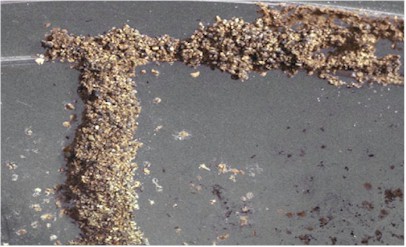Subterranean Termites
Termites are social insects that live in colonies where labor is
divided among a caste system. All members of a colony are related,
originating from a single pair. There are three distinct types of
individuals: reproductives, soldiers and workers.
Reproductives are sexually mature males and females and are
responsible for producing offspring and establishing new colonies.
Soldiers have larger heads and mandibles (“jaws”) that they use to
defend the colony. Workers (Fig. 1) make up the largest portion of
the colony and are responsible for enlarging the colony.

Termite damage usually starts at the mudsill in houses built over a
crawl space and at the sole plates of those houses built on concrete
slabs. Given enough time, subterranean termites will extend the
damage into the wooden floor members, the interior trim and
furnishings, and into the walls to the roof timbers.

Preventing
damage is done by one of two basic
approaches. #1 The application of either pre- or post-construction
soil termiticides (insecticides that target termites) to treat the
soil that termites live in. #2 Installing termite monitoring around
existing structures.
Termite Facts:
- In some countries Termites are made into cooking oil.
- Termites are fried and sold like food in Zaire.
- The protein content of termites is higher than in beef.
- Subterranean termites, the most common kind, live in the soil, from just below the surface to as much as 12 feet down.
- Subterranean termites, the most common kind, live in the soil, from just below the surface to as much as 12 feet down.
- Up to two million termites inhabit a colony.
- These colonies consist of a network of tunnels and chambers built around a King and Queen whose sole job is to reproduce.
- Some of the 55 termite species, queens can lay up to 86,000 eggs a day!
- Often the queen's swollen body can weigh more than a pencil.
- The rest of the colony is made up of termites who all play specific roles in keeping the colony healthy.
- Worker termites keep busy 24 hours a day digesting wood fibers and other forms of cellulose which they eat, digest and share with the other members of the colony.
- Workers also clean the royal pair, the King and Queen, and carry away the eggs.
